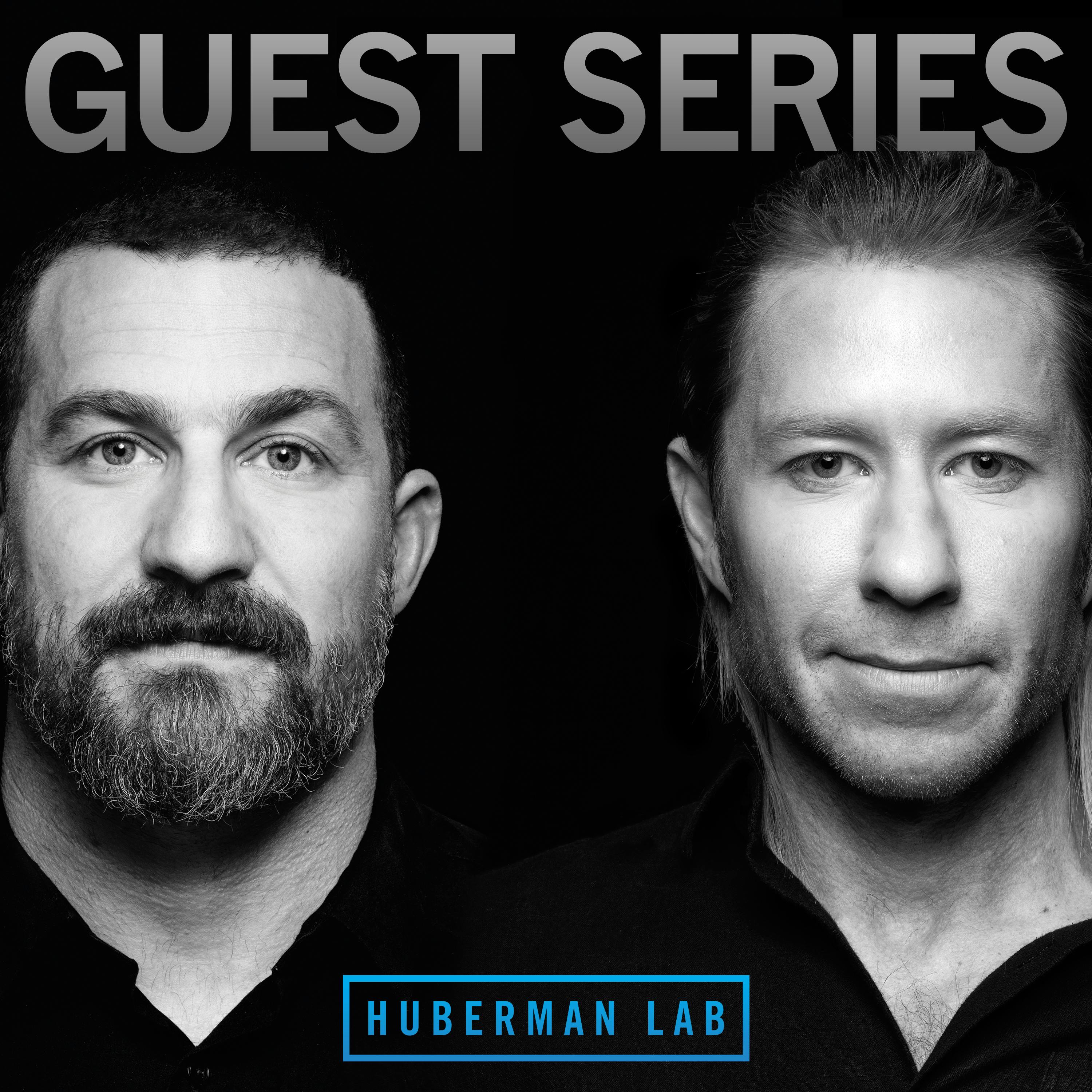
May 8, 2024 • 2hr 33min
GUEST SERIES | Dr. Matt Walker: The Science of Dreams, Nightmares & Lucid Dreaming
Huberman Lab

Key Takeaways
- Dreaming, especially during REM sleep, is a normal and essential part of the sleep cycle, despite the bizarre and hallucinatory nature of dreams
- REM sleep and dreaming play important roles in creativity, emotional regulation, and resolving challenges from waking life
- While dream content is highly personal and symbolic, dreams can provide insights into our emotional experiences and subconscious processes
- Recurring nightmares can be treated effectively using techniques like image rehearsal therapy and targeted memory reactivation during sleep
- Lucid dreaming, where one is aware they are dreaming, may have some benefits but also potential downsides in terms of sleep quality
- Practical tips are provided for remembering dreams, managing middle-of-the-night wakings, and using supplements to support sleep
Introduction
In this episode, Dr. Matthew Walker, a leading sleep researcher, discusses the fascinating topic of dreaming and its role in human psychology and neurobiology. Dreaming, which primarily occurs during REM (rapid eye movement) sleep, is a normal and essential part of the sleep cycle, despite the bizarre and hallucinatory nature of dreams.
Dr. Walker explains the biological mechanisms underlying dreaming, including the unique patterns of brain activity that distinguish REM sleep from other sleep stages. He also explores the evolutionary significance of REM sleep and dreaming, as well as the potential functions dreams serve in terms of creativity, emotional regulation, and resolving challenges from waking life.
The discussion covers topics such as dream interpretation, the relationship between dream content and daily experiences, and techniques for remembering and even influencing one's dreams, such as lucid dreaming. The episode also addresses the issue of recurring nightmares and effective therapeutic approaches for managing them.
Topics Discussed
Dreams and REM Sleep (5:06)
- Dreaming is a normal, biological process that occurs primarily during REM sleep
- REM sleep is characterized by high brain activity, rapid eye movements, and muscle paralysis
- Waking up from REM sleep often results in vivid, bizarre, and emotionally-charged dream reports
The Evolution of REM Sleep and Dreaming (12:20)
- Humans have an unusually high proportion of REM sleep compared to other mammals, suggesting its evolutionary importance
- Early studies in rats found that total sleep deprivation led to death within 2-3 weeks, while selective REM sleep deprivation led to death within 4-6 weeks
- The function of REM sleep and dreaming remains an active area of research and debate
The Neurobiology of Dreaming (17:13)
- During REM sleep, the brain exhibits unique patterns of activity, including PGO (pons-geniculate-occipital) waves
- Brain imaging studies show increased activity in memory, emotion, and visual processing regions during REM sleep dreaming
- The prefrontal cortex, responsible for logical reasoning, shows decreased activity during REM sleep, contributing to the bizarre and illogical nature of dreams
Dreams and Waking Life Experiences (41:27)
- Dreams are not a faithful replay of waking experiences, but rather an abstraction and recombination of emotional concerns and significant people from daily life
- There is a "red thread" of emotional themes and personal significance that connects dream content to waking experiences
- Dreams may serve a therapeutic function, helping to process and resolve emotional challenges from the day
Dream Interpretation and Meaning (45:08)
- While Freudian dream interpretation has been largely discredited, exploring one's own dreams can provide valuable insights
- Dreams often use symbolism and abstraction, reflecting the brain's "fuzzy logic" during REM sleep
- The best "interpreter" of one's dreams is often the dreamer themselves, as dreams are highly personal and idiosyncratic
Nightmares and Therapeutic Approaches (1:01:36)
- Recurring nightmares can be treated effectively using techniques like image rehearsal therapy and targeted memory reactivation during sleep
- Image rehearsal therapy involves replacing the nightmare narrative with a more neutral or positive ending, which is then rehearsed and reinforced during sleep
- Targeted memory reactivation uses subtle sensory cues (e.g., sounds) during sleep to help consolidate the new, less distressing dream narrative
Lucid Dreaming (1:18:53)
- Lucid dreaming is the state of being aware that one is dreaming while in the dream state
- While lucid dreaming can be an intriguing experience, it may come at the cost of reduced sleep quality and restorative benefits
- Techniques like the "reality testing method" can help increase the likelihood of experiencing lucid dreams
Practical Tips for Sleep and Dreams (1:57:15)
- Strategies for remembering dreams, such as remaining still and visualizing the dream upon waking
- Recommendations for managing middle-of-the-night wakings, including relaxation techniques and avoiding checking the clock
- Potential sleep-supportive supplements, including magnesium, chamomile, and glycine, though lifestyle factors are most important
Conclusion
This episode provides a comprehensive exploration of the science and significance of dreaming, drawing on the latest research in sleep neuroscience. Dr. Walker delves into the biological mechanisms underlying REM sleep and dreaming, as well as the potential functions dreams serve in terms of creativity, emotional regulation, and resolving challenges from waking life.
The discussion also covers the complex and often symbolic nature of dream content, the role of dream interpretation, and effective therapeutic approaches for managing recurring nightmares. While lucid dreaming is an intriguing phenomenon, the potential downsides in terms of sleep quality are also discussed.
Throughout the episode, Dr. Walker offers practical tips and science-based recommendations for optimizing sleep, remembering dreams, and using supplements to support sleep and overall well-being. By the end, listeners have a deeper understanding of the fascinating world of dreams and their importance for human health and functioning.







